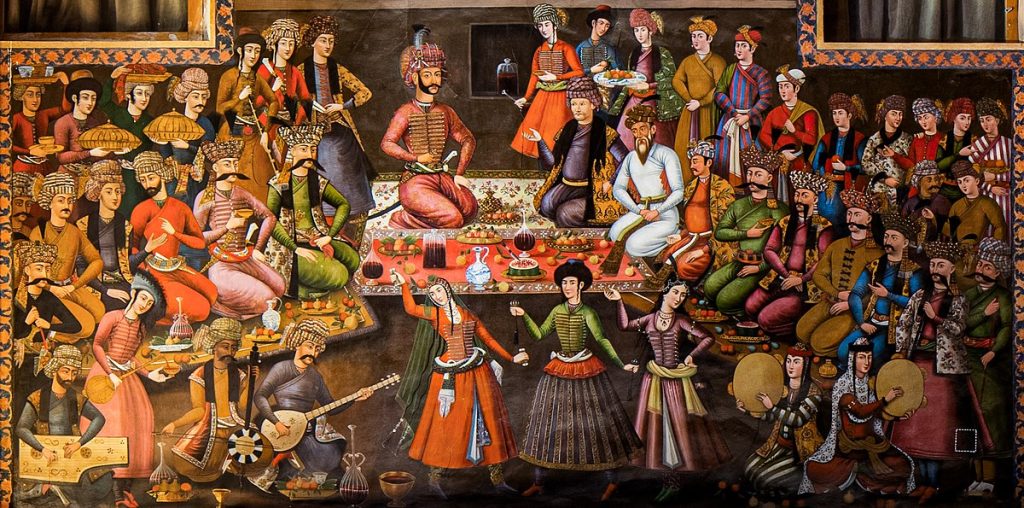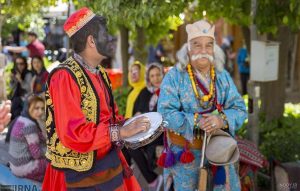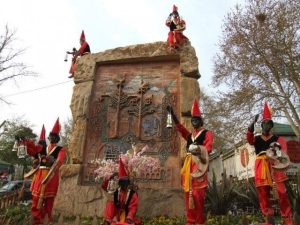This text is about Persian New Year or Nowruz. Nowruz, also known as the Persian New Year, is a deeply rooted and widely celebrated festival that marks the arrival of spring. It’s a time of renewal, rebirth, and the celebration of nature’s awakening. Here’s a deeper look into this significant cultural event:

Persian New Year or Nowruz
“Nowruz, the first day of the solar year, coinciding with the first of Farvardin, is the celebration of the Persian New Year and one of the oldest festivals remaining from ancient Iran. Nowruz originates in ancient Iran and is celebrated in vast regions of Asia and other parts of the world. The timing of Nowruz is the vernal equinox, at the beginning of the spring season. Nowruz, with the official title ‘International Nowruz Day,’ has been globally registered by UNESCO as an intangible cultural heritage of humanity.
Nowruz has been inherited from ancient Iran as an old and ancient celebration and is remembered as a symbol connecting the people and ethnicities of the Iranian plateau and the Iranian nation. Iranians consider Nowruz the beginning of nature’s revival, a time of growth and birth for gardens and orchards, and they believe that in Nowruz, along with nature, a new era should begin with a new spirit and perspective, in a fresh attire. This day is also considered one of the holy days and religious holidays of Zoroastrians and Baha’is.”
Here’s a breakdown of the key elements:
- Nowruz’s Significance:
- It marks the Persian New Year.
- It’s a very old tradition from ancient Persia (Iran).
- It’s celebrated widely.
- Timing:
- It occurs at the vernal equinox (the start of spring).
- International Recognition:
- UNESCO has recognized it as an important cultural heritage.
- Cultural Importance:
- It symbolizes unity among Iranian people.
- It represents nature’s rebirth.
- It’s a holy day for certain religious groups.
- Symbolism:
- It is a time for renewal, of both nature and the inner self.
The Psychology of Learning Persian Language
How long does it take to learn Persian?

Origins and Significance:
- Ancient Roots:
- Nowruz has its origins in Zoroastrianism, an ancient Persian religion, and its history stretches back over 3,000 years.
- It signifies the vernal equinox, the moment when the sun crosses the celestial equator, marking the beginning of spring in the Northern Hemisphere.
-
Symbolism:
- Nowruz symbolizes the triumph of light over darkness, and the renewal of life.
- It’s a time for families and communities to come together, celebrate, and reflect on the past year while looking forward to new beginnings.
-
Cultural Importance:
- Nowruz is celebrated by diverse ethnic and religious groups across various countries, including Iran, Afghanistan, Tajikistan, Azerbaijan, and Kurdish communities, among others.
- It’s a secular holiday that transcends religious boundaries, bringing people together in a shared celebration.
- It is registered on the UNESCO Representative List of the Intangible Cultural Heritage of Humanity.

Traditions and Customs:
- Haft-Sin:
- A central tradition is the setting of the Haft-Sin table, which displays seven symbolic items that begin with the Persian letter “sin” (س). These items represent various aspects of life, such as health, prosperity, and renewal.
- Spring Cleaning (Khaneh Tekani):
- People engage in thorough spring cleaning to symbolize the cleansing of the old year and preparing for a fresh start.
- Family Gatherings:
- Nowruz is a time for families to gather, exchange gifts, and enjoy festive meals.
- 13th Day Celebrations (Sizdah Bedar):
- On the 13th day of Nowruz, people often go outdoors for picnics and celebrations, symbolizing the warding off of bad luck.

International Recognition:
- United Nations Recognition:
- The United Nations General Assembly has recognized March 21st as the International Day of Nowruz, highlighting its cultural significance and promoting peace and solidarity.
Nowruz is more than just a new year celebration; it’s a celebration of life, nature, and the enduring spirit of renewal.
Learn Persian language in Tehran
Brain Effects of learning Persian
Persian Learning: Arabic vs. Latin Backgrounds
Teaching and learning Persian using AI tools
ِDifferent Dictation of Persian New Year or Nowruz
Nowruz, Norooz, Norouz, Nouruz, Nowrooz, Nawroz, Nawrouz, Novruz, Nooruz, Nowrouz, Nourouz, Nawrouz, Nouruz.
Nowruz is a celebration with deep historical roots, and it’s observed by diverse populations across a wide geographical area. Here are some of the key countries where Nowruz is celebrated:
Iran: As the origin of Nowruz, it holds a central place in Iranian culture.
Afghanistan: Nowruz is a significant national holiday.
Azerbaijan: It’s a widely celebrated public holiday.
Tajikistan: Nowruz is a cherished tradition.
Uzbekistan: It’s a time for communal celebrations.
Kazakhstan: Nowruz, or Nauryz, is a spring festival.
Kyrgyzstan: It’s a time for traditional festivities.
Turkmenistan: Nowruz is a national celebration.
Pakistan: Particularly in regions with Persian cultural influence.
Turkey: Especially within Kurdish communities.
India: Celebrated by various communities, notably in Kashmir.
Iraq: Particularly by Kurdish populations.
Persian Language Training Tour
Persian Language Training camp
Private Persian conversation Class Online
Persian Free Discussion Course
It’s important to note that Nowruz is celebrated by diverse ethnic and religious groups, and its reach extends beyond these countries. Additionally, UNESCO recognizes the international significance of Nowruz.
Persian New Year or Nowruz Time
“The Nowruz celebration begins with the ‘Tahvil-e Saal’ (the moment of the year’s turn) or the moment of the vernal equinox; a moment when the sun, in its apparent motion at the beginning of the Aries constellation, crosses the Earth’s equator, and the equality of day and night occurs. In the Solar Hijri calendar, the moment of Tahvil-e Saal determines the first day (Hormoz Day or Ormazd Day) of the month of Farvardin. If the beginning of the year occurs before noon and in the first half of the day, that day is Nowruz, and if the Tahvil-e Saal is after noon, the next day is Nowruz. In the Gregorian calendar, Nowruz usually corresponds to March 21, sometimes March 20, and rarely March 22.
In Iran, where the Solar Hijri calendar is used, Nowruz is the day of the New Year’s beginning. However, in Central Asian and Caucasian countries, the Gregorian calendar is common, and Nowruz is celebrated as the beginning of the spring season and is not considered the day of the New Year’s beginning.”
Here’s a breakdown of the key points:
- Timing of Nowruz:
- It starts with the exact moment of the vernal equinox.
- This is when the sun crosses the Earth’s equator, resulting in equal day and night.
- The precise moment determines whether Nowruz falls on one day or the next.
-
Calendar Differences:
- In Iran, using the Solar Hijri calendar, Nowruz is the official New Year.
- In Central Asia and the Caucasus, where the Gregorian calendar is used, Nowruz is primarily a celebration of the spring season, not necessarily the start of the calendar year.
-
Gregorian Calendar Correlation:
- Nowruz typically falls on March 21st, with occasional variations to March 20th or 22nd.
Who Is a Good Persian Teacher? Essential Characteristics
4 main skills needed to learn Persian Language
Nowruz Word
The word Nowruz originates from Middle Persian nwklwc (transliterated as nōgrōz) and is derived from the Avestan language. Historians speculate that its Avestan equivalent is navaka raocah.
Today, the term is generally applied to the vernal equinox and the beginning of the New Year, but in a specific sense, it is used for the sixth day of Farvardin (named ‘Khordad Day’).
Ancient Iranians referred to Nowruz as ‘Nava Sareda,’ meaning ‘New Year.’ The Iranian people of Central Asia, such as the Sogdians and Khwarazmians, called Nowruz ‘Nosard’ and ‘Nosarji,’ also meaning ‘New Year.’
In various Latin texts, the first part of the word Nowruz is spelled as No, Now, Nov, and Naw, and the second part as Ruz, Rooz, and Rouz. In some cases, the two parts are written consecutively, and in others, they are separated. The pronunciation of Nowruz varies in different countries. In the city of Lucknow, India, where Nowruz is celebrated annually and a weekly magazine named Nowruz is published, it is pronounced as Nauroz, which is close to the Dari dialect pronunciation. According to Ehsan Yarshater, the founder of the Encyclopaedia Iranica, the writing of this word in the Latin alphabet in accordance with phonetic rules is recommended as Nowruz (which, of course, is based on the Iranian Persian pronunciation). This form of spelling the word Nowruz is currently used in UNESCO writings and many political texts.
Nowruz in Middle Persian was /no:g ro:z/. In Iranian Persian, the word is pronounced [nou̯ɾu:z] (in colloquial speech, [no:ɾu:z]), in Afghan Persian [næu̯ɾo:z], and in Tajik Persian [næu̯ɾʉz] or [næu̯ɾɵz] (the pronunciations are in IPA).
Origin and Time of Nowruz
The origin and time of Nowruz’s emergence are not precisely known. Some historical accounts attribute the beginning of Nowruz to the Babylonians. According to these accounts, the spread of Nowruz in Iran dates back to 538 BC, the time of Cyrus the Great’s conquest of Babylon.
A prominent relief depicts the marriage of Dumuzi (a plant deity in Sumerian mythology) with Inanna (the goddess of fertility). It appears that the two Iranian narratives (the story of Siavash) and Indian narratives (the myth of Rama and Sita) are related to the ancient Mesopotamian narrative of Dumuzi and Inanna, indicating the cultural connection of the entire region.
The people of Babylon celebrated the first day of the year (generally at the vernal equinox, around March 21st). This time coincides with the awakening of nature. Tablets indicate that this celebration was known approximately from 2340 BC.
Mary Boyce believes that Iranians have long held major celebrations such as spring and autumn festivals (Mehrgan), based on Mithraism, but the grandeur of the Babylonian spring festival may have led Iranians to hold their New Year celebration during this time.
The New Year’s festival in Mesopotamia (Babylon and Assyria), as well as in Elam, was originally the return of the martyred deity, Dumuzi, whom believers thought died every year and returned to life. His death was the death of the plant world, and his rebirth was the rebirth of the plant world. Then, following mourning for the martyred deity as a symbol of blessing, life, and the death of the plant world, many tears were shed, which symbolized rain and a kind of rain-bringing and water magic. Following this mourning and weeping, the martyred deity would come back to life on Nowruz and life would resume.
Ceremony at the beginning of spring
The Phoenicians had a ceremony at the beginning of spring called the Adonis ceremony. Adonis is a plant spirit whose death and return to life represent the sleep of nature in winter and its revival in spring. Adonis was born from a tree, and people used the oil of that tree in the festival related to the New Year’s day, which was the first day of the vernal equinox. A characteristic of the celebration was the planting of green seeds in flowerpot containers. This custom is still common among Cypriot Christians. People called these green containers Adonis’s gardens. Then, after a few days of mourning, they threw these greens into the seas or flowing waters. The main purpose of these ceremonies was to stimulate the fertility of the earth and the growth of plants, and the purpose of throwing the greens into the water was to ensure rain. Also, in some accounts, Zoroaster is mentioned as the founder of Nowruz.”
Key takeaways from the translation:
-
Diverse Origins:
- The text highlights that Nowruz’s origins are complex, with potential influences from Babylonian, Sumerian, Phoenician, and Iranian cultures.
-
Symbolism of Rebirth:
- The recurring theme is the symbolism of nature’s rebirth, tied to the vernal equinox and deities associated with plant life.
- Cultural Exchange:
- The text emphasizes the cultural connections between ancient civilizations in Mesopotamia, Iran, and the Mediterranean region.
- Religious and Mythological Links:
- It shows the deep roots of Nowruz in ancient religious and mythological beliefs.
- Theories of influence:
- It mentions the influence that babylonian spring festivals may have had on the iranian calender.
- Zoroastrian influence:
- It also mentions the belief that zoroaster was the founder of Nowruz.
In Mythology
Stone carvings in Persepolis, which show a symbol of Zoroastrian Nowruz. At the vernal equinox on the first day of Nowruz, the strength and power of the lion and the bull are equal in battle. The lion symbolizes the deity Mithra or the sun, and the bull symbolizes the earth.
In some ancient Iranian texts, including Ferdowsi’s Shahnameh and Tarikh-e Tabari, Jamshid, and in some other texts, Keyumars, are introduced as the founders of Nowruz.
The creation of Nowruz in the Shahnameh is narrated as follows: Jam (Yima), while passing through Azerbaijan, descended on the Arg-e Jamshid (Persepolis) and sat on the throne with a golden crown. When the sunlight reached his golden crown, the world became illuminated, and people rejoiced, and they named that day ‘New Day’ and Jam ‘Jamshid.’
Major mythological figures such as Jamshid, Siavash, and Keykhosrow have a close connection with Nowruz. Nowruz is the day of Jamshid’s great victory over the demons, who symbolized impurities such as cold, darkness, ignorance, and violence. Jamshid’s ascension and Keykhosrow’s ascension took place on this day, which has various interpretations. On this day, Jamshid observed the unseen world in the Jam-e Jahan-Nama (the Cup of the World), the same cup in which Keykhosrow saw Bijan’s location and sent Rostam after him. However, the story of Siavash’s transformation and rebirth is a special story that can be compared to narratives such as Adonis, Persephone, Osiris, or Tammuz.”
Here’s a breakdown of the key points:
- Symbolism in Persepolis:
- The lion and bull battle represents the balance of power at the vernal equinox.
- The lion and bull are symbols of Mithra/sun and earth, respectively.
- Mythical Founders:
- Jamshid and Keyumars are credited as founders in different texts.
- The Shahnameh narrates Jamshid’s role in establishing Nowruz.
- Mythological Connections:
- Key figures like Jamshid, Siavash, and Keykhosrow are linked to Nowruz.
- Nowruz symbolizes Jamshid’s victory over evil.
- Ascensions of Jamshid and Keykhosrow are associated with this day.
- Jamshids “Jam-e Jahan-Nama” is also associated with Nowruz.
- Siavash’s Story:
- Siavash’s story of rebirth is comparable to other mythological figures associated with seasonal renewal.
In essence, the text explores the rich mythological context of Nowruz, highlighting its connections to ancient Iranian legends and its symbolic representation of renewal and victory over darkness.